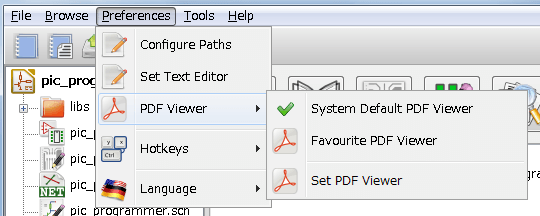
Reference manual
Copyright
This document is Copyright © 2010-2015 by its contributors as listed below. You may distribute it and/or modify it under the terms of either the GNU General Public License (http://www.gnu.org/licenses/gpl.html), version 3 or later, or the Creative Commons Attribution License (http://creativecommons.org/licenses/by/3.0/), version 3.0 or later.
All trademarks within this guide belong to their legitimate owners.
Contributors
Jean-Pierre Charras, Fabrizio Tappero.
Feedback
Please direct any bug reports, suggestions or new versions to here:
-
About KiCad document: https://github.com/KiCad/kicad-doc/issues
-
About KiCad software: https://bugs.launchpad.net/kicad
-
About KiCad software i18n: https://github.com/KiCad/kicad-i18n/issues
Publication date and software version
2015, may 21.
Introduction
KiCad
KiCad is an open-source software tool for the creation of electronic schematic diagrams and PCB artwork. Beneath its singular surface, KiCad incorporates an elegant ensemble of the following software tools:
-
KiCad : project manager
-
Eeschema : schematic editor and component editor
-
CvPcb : footprint selector helper (always run from Eeschema)
-
Pcbnew : circuit board layout editor and footprint editor
-
GerbView : Gerber viewer
3 utilities are included
-
Bitmap2Component: component maker for logos. It creates a schematic component or a footprint from a bitmap picture.
-
PcbCalculator: A calculator that is helpful to calculate components for regulators, track width versus current, transmission lines…
-
PlEditor: Page Layout Editor.
These tools are usually run from the project manager, but can be also run as stand-alone tools.
At the time of writing, KiCad is considered mature and can be used for the successful development and maintenance of complex electronic boards.
KiCad does not present any board-size limitation and it can handle up to 32 copper layers, 14 technical layers and 4 auxiliary layers.
KiCad can create all the files necessary for building printed boards:
-
Gerber files for photo-plotters
-
drilling files
-
component location files
-
and a lot more.
Being open source (GPL licensed), KiCad represents the ideal tool for projects oriented towards the creation of electronic hardware with an open-source flavour.
KiCad is available for Linux, Windows and Apple OS X (still experimental, but is now working well).
KiCad files and folders
KiCad creates and uses files with the following specific file extensions (and folders) for schematic and board editing.
Project manager file:
*.pro |
Small file containing a few parameters for the current project, including the component library list. |
Schematic editor files:
*.sch |
Schematic files, which do not contain the components themselves. |
*.lib |
Schematic component library files, containing the component descriptions: graphic shape, pins, fields. |
*.dcm |
Schematic component library documentation, containing some component descriptions: comments, keywords, reference to data sheets. |
*_cache.lib |
Schematic component library cache file, containing a copy of the components used in the schematic project. |
Board editor files and folders:
*.kicad_pcb |
Board file containing all info but the page layout. |
*.pretty |
Footprint library folders. The folder itself is the library. |
*.kicad_mod |
Footprint files, containing one footprint description each. |
*.brd |
Board file in the legacy format. Can be read, but not written by the board editor. |
*.mod |
Footprint library in the legacy format. Can be read by the footprint or the board editor, but not written. |
fp-lib-table |
Footprint library list (footprint libraries table): list of footprint libraries (various formats) which are loaded by the board or the footprint editor or CvPcb. |
Common files:
*.kicad_wks |
The page layout description files, for people who want a worksheet with a custom look. |
*.net |
Netlist file created by the schematic, and read by the board editor. This file is associated to the .cmp file, for users who prefer a separate file for the component/footprint association. |
Special file:
*.cmp |
Stores the association between components used in the schematic and their footprints. It can be created by Pcbnew, and imported by Eeschema. The purpose is a back import from Pcbnew to Eeschema, for users who change footprints inside Pcbnew (for instance using Exchange Footprints command) and want to import these changes in schematic. |
Other files:
They are generated by KiCad for fabrication or documentation.
*.gbr |
Gerber files, for fabrication |
*.drl |
Drill files (Excellon format), for fabrication. |
*.pos |
Position files (ascii format), for automatic insertion machines. |
*.rpt |
Report files (ascii format), for documentation. |
*.ps |
Plot files (postscript), for documentation. |
Plot files (pdf format), for documentation. |
|
*.svg |
Plot files (svg format), for documentation. |
*.dxf |
Plot files (dxf format), for documentation. |
*.plt |
Plot files (HPGL format), for documentation. |
Installation and configuration
Display options
Pcbnew needs the support of OpenGL v2.1 or more.
Initialization of the default configuration
A default configuration file named kicad.pro is supplied in kicad/template. It serves as a template for any new project.
If another default configuration file named fp-lib-table exists, it will be used only once to create a footprint library list. (or else, this list will be created from scratch)
The default file kicad.pro can be freely modified if necessary, mainly to set the list of library files loaded by Eeschema.
A few other parameters (default text size, default line thickness, mainly for Pcbnew) are stored here.
Verify that you have write access to kicad/template/kicad.pro
Run KiCad and load kicad.pro project.
Run Eeschema via KiCad. Modify and update the Eeschema configuration, and mainly the list of libraries you want to use each time you create new projects.
Run Pcbnew via KiCad. Modify and update the Pcbnew configuration, especially the footprint library list. Pcbnew will create or update a library list file called footprint library table. There are 2 library list files (named fp-lib-table). The first (located in the user home directory) is global for all projects. The second, if it exists (located in the project directory) is specific to the project.
Initialization of some options and utilities
When using KiCad, a text editor and a PDF viewer are useful. Setting them is a good idea.
These settings are accessible from the Preference menu

3 options are especially important:
-
Configure Paths
-
PDF Viewer
-
Set Text Editor
Configuration of paths
In KiCad, one can define some paths using an environment variable. A few environment variables are internally defined by KiCad, and can be used to define paths (for libraries, 3D shapes, etc).
This is useful when absolute paths are not known or are subject to change. This is the case for ``official'' libraries built for KiCad:
-
for the path of these libraries, when installed on your disk
-
for the path of 3D shapes files used in footprint definitions.
For instance, the full path of connect.pretty footprint library is defined like this, when using the KISYSMOD environment variable to define the full path: ${KISYSMOD}/connect.pretty
Obviously, one can use a usual full path definition, if this full path is well known, and never changes.
This option allows you to define some paths from an environment variable, and add your own environment variables, to define personal paths, if needed.
KIGITHUB |
frequently used in footprint lib tables examples. If you are using this variable, it must be defined. |
KISYS3DMOD |
default base path of 3D shapes files, and must be defined, because an absolute path is not usually used. |
KISYSMOD |
default base path of footprint library folders, and must be defined, if an absolute path is not used in footprint library names. |

Note also the environment variable
-
KIPRJMOD
is always internally defined by KiCad, and is the current project absolute path.
For instance, ${KIPRJMOD}/connect.pretty is always the connect.pretty folder (the pretty footprint library) found inside the current project folder.
-
If you modify the configuration of paths, please quit and rerun KiCad, to avoid any issues in path handling.
Initialization of the text editor
Before using a text editor to browse/edit files in the current project, you have to choose the text editor you want to use. The menu:
Preferences/SetText Editor
allows you to set the text editor to use.
Initialization of the PDF viewer
You can use the default PDF viewer or choose your own PDF viewer.
Select Preferences/PDF Viewer/Favourite PDF Viewer to choose your favourite (default) PDF Viewer.
Your own (non default) viewer is chosen by using the Preferences/PDF Viewer/SetPDF Viewer menu.
On Linux, the default PDF viewer is known to be sometimes strange, so using Favourite PDF Viewer after selecting a suitable PDF viewer is mandatory.
KiCad: principles of use
In order to manage a KiCad project: schematic files, printed circuit board files, supplementary libraries, manufacturing files for photo-tracing, drilling and automatic component placement files, it is recommended to create a project as follows:
-
Create a working directory for the project (using KiCad or by other means).
-
In this directory, use KiCad to create a project file (file with extension .pro) via the "Create a new project" or "Create a new project from template" icon.
| It is recommended to use a unique directory for each KiCad project. Do not combine multiple projects into a single directory. |
KiCad creates a file with a .pro extension that maintains a number of parameters for project management (such as the list of libraries used in the schematic). Default names of both main schematic file and printed circuit board file are derived from the name of the project. Thus, if a project called example.pro was created in a directory called example , the default files will be created:
example.pro |
project management file. |
example.sch |
main schematic file. |
example.kicad_pcb |
printed circuit board file. |
example.net |
netlist file. |
example.xxx |
various files created by the other utility programs. |
example-cache.lib |
library file automatically created and used by the schematic editor. (It contains a backup of the components used in the schematic). |
Use KiCad Manager
The KiCad Manager (kicad or kicad.exe file) is a tool which can easily run the other tools (editors, gerber viewer and utility tools) when creating a design.
Running the other tools from KiCad manager has some advantages:
-
cross probing between schematic editor and board editor.
-
cross probing between schematic editor and footprint selector (CvPcb).
But you can only edit the current project files.
(When these tools are run in stand alone mode, you can open any file in any project but cross probing between tools can give strange results)
Main window

The main KiCad window is composed of a project tree view, a launch pane containing buttons used to run the various software tools, and a message window. The menu and the toolbar can be used to create, read and save project files.
Utility launch pane
KiCad allows you to run all stand alone software tools that come with it.
The launch pane is made of the 8 buttons below that correspond to the following commands (1 to 8, from left to right):

1 |
Eeschema |
The schematic editor. |
2 |
LibEdit |
The component editor and component library manager. |
3 |
Pcbnew |
The board layout editor. |
4 |
FootprintEditor |
The footprint editor and footprint library manager. |
5 |
Gerbview |
A GERBER file viewer. It can also show drill files. |
6 |
Bitmap2component |
A tool to build a footprint or a component from a B&W bitmap image to create logos. |
7 |
Pcb Calculator |
A tool to calculate track widths, and many other things. |
8 |
Pl Editor |
The Page Layout editor, to create/customize frame references. |
Project tree view
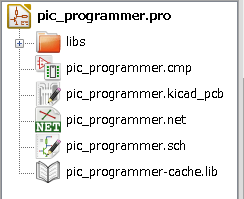
-
Double-clicking on the Eeschema icon runs the schematic editor which in this case will open the file pic_programmer.sch.
-
Double-clicking on the Pcbnew icon runs the layout editor, in this case opening the file pic_programmer.kicad_pcb.
-
Right clicking on any of the files in the project tree allows generic file manipulation.
Top toolbar

KiCad top toolbar allows for some basic files operation (from left to right).
|
Create a project file. If the template kicad.pro is found in kicad/template, it is copied into the working directory. |
|
Create a project from a template. |
|
Open an existing project. |
|
Update and save the current project tree. |
|
Create a zip archive of the whole project. This includes schematic files, libraries, pcb, etc. |
|
Rebuild and redraw the tree list, sometimes needed after a tree change. |
Using templates
Definitions
A template is a directory of files, which includes a directory of metadata.
The template system name (SYSNAME) is the directory name under which the template files are stored. The metadata directory (METADIR) contains pre-defined files which provide information about the template.
All files and directories in a template are copied to the new project path when a project is created using a template, except METADIR.
All files and directories which start with SYSNAME will have SYSNAME replaced by the new project file name, excluding the file extension.
Templates
They facilitate the easy setup of projects which have common attributes such as pre-defined board outlines, connector positions, schematic elements, design rules, etc. .
Metadata
A template’s METADIR must contain the required files, and might optionally contain any of the optional files.
Required Files:
meta/info.html
Contains html formatted information about the template which is used by the user to determine if the template is what they are after. The <title> tag determines the actual name of the template that is exposed to the user for template selection.
Using html to format this document means that images can be in-lined without having to invent a new scheme.
Only a basic HTML language can be used to format this document.
Optional Files:
meta/icon.png
A 64 x 64 pixels PNG icon file which is used as a clickable icon in the template selection dialog.
Example:
Here is a template for a raspberrypi-gpio board:
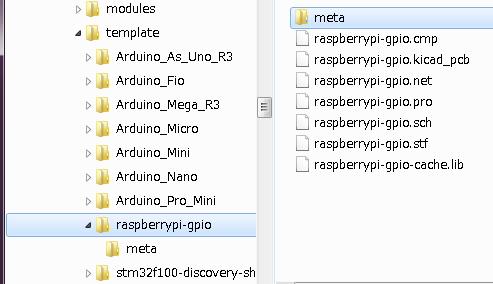
And the meta data info:
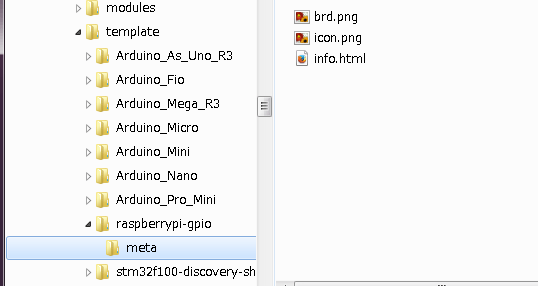
brd.png is an optional file.
Here is an info.html file sample:
<!DOCTYPE HTML PUBLIC "-//W3C//DTD HTML 4.0 Transitional//EN">
<HTML>
<HEAD>
<META HTTP-EQUIV="CONTENT-TYPE" CONTENT="text/html;
charset=windows-1252">
<TITLE>Raspberry Pi - Expansion Board</TITLE>
<META NAME="GENERATOR" CONTENT="LibreOffice 3.6 (Windows)">
<META NAME="CREATED" CONTENT="0;0">
<META NAME="CHANGED" CONTENT="20121015;19015295">
</HEAD>
<BODY LANG="fr-FR" DIR="LTR">
<P>This project template is the basis of an expansion board for the
<A HREF="http://www.raspberrypi.org/" TARGET="blank">Raspberry Pi $25
ARM board.</A> <BR><BR>This base project includes a PCB edge defined
as the same size as the Raspberry-Pi PCB with the connectors placed
correctly to align the two boards. All IO present on the Raspberry-Pi
board is connected to the project through the 0.1" expansion
headers. <BR><BR>The board outline looks like the following:
</P>
<P><IMG SRC="brd.png" NAME="brd" ALIGN=BOTTOM WIDTH=680 HEIGHT=378
BORDER=0><BR><BR><BR><BR>
</P>
<P>(c)2012 Brian Sidebotham<BR>(c)2012 KiCad Developers</P>
</BODY>
</HTML>Operation
The KiCad File menu New shows 2 option:
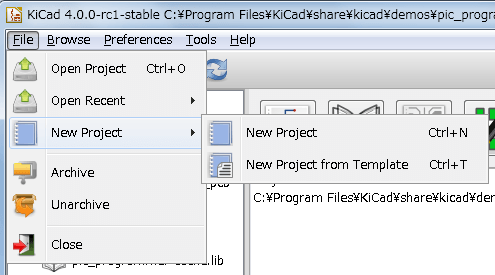
-
New Project Create a blank project by just copying template/kicad.pro to the current folder.
-
Project from Template Opens the template selection dialog. The template selection dialog has a list of icons, and a display window. A single click on a template’s icon on the top will load that template’s info.html metadata file and display it in the display window. A click on the OK button starts the new project creation. The template will be copied to the new project location (excluding METADIR as mentioned earlier) and any files that match the string replacement rules will be renamed to reflect the new project’s name.
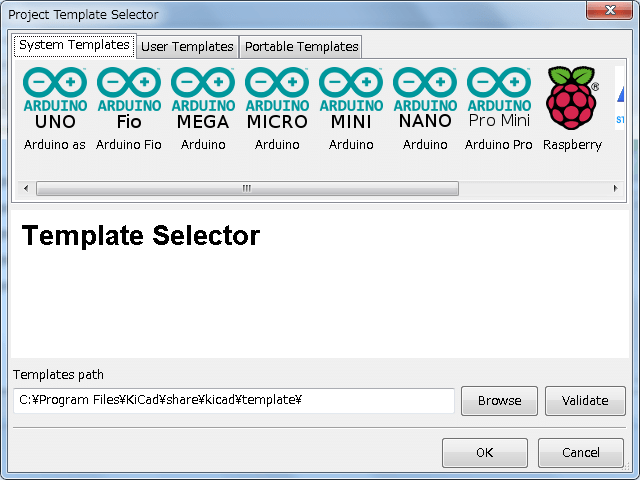
After selection of a template:
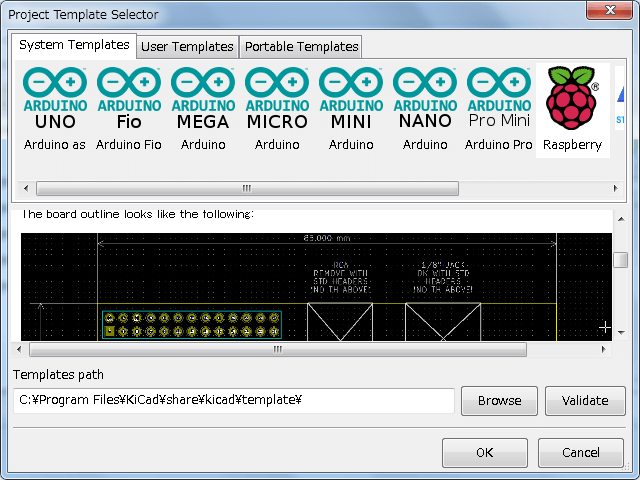
Templates Location:
The list of available templates are gathered from the following sources:
-
For system templates: <kicad bin dir>/../share/template/
-
For user templates:
-
on Unix: ~/kicad/templates/
-
on Windows: C:\Documents and Settings\username\My Documents\kicad\templates
-
on Mac: ~/Documents/kicad/templates/
-
-
When the environment variable KICAD_PTEMPLATES is defined, there is a third page: Portable Templates, which lists templates found in KICAD_PTEMPLATES path.